
An asteroid is a minor planet of the inner Solar System. Historically, these terms have been applied to any astronomical object orbiting the Sun that did not resolve into a disc in a telescope and was not observed to have characteristics of an active comet such as a tail. As minor planets in the outer Solar System were discovered that were found to have volatile-rich surfaces similar to comets, these came to be distinguished from the objects found in the main asteroid belt. Thus the term "asteroid" now generally refers to the minor planets of the inner Solar System, including those co-orbital with Jupiter. Larger asteroids are often called planetoids.
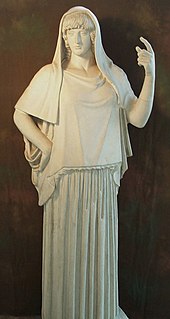
In the Ancient Greek religion, Hestia is the virgin goddess of the hearth, the right ordering of domesticity, the family, the home, and the state. In Greek mythology, she is the firstborn child of the Titans Cronus and Rhea.

Vesta is one of the largest objects in the asteroid belt, with a mean diameter of 525 kilometres (326 mi). It was discovered by the German astronomer Heinrich Wilhelm Matthias Olbers on 29 March 1807 and is named after Vesta, the virgin goddess of home and hearth from Roman mythology.
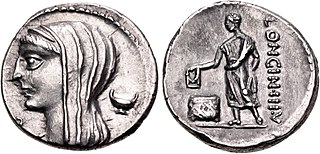
Vesta is the virgin goddess of the hearth, home, and family in Roman religion. She was rarely depicted in human form, and was often represented by the fire of her temple in the Forum Romanum. Entry to her temple was permitted only to her priestesses, the Vestals, who tended the sacred fire at the hearth in her temple. As she was considered a guardian of the Roman people, her festival, the Vestalia, was regarded as one of the most important Roman holidays. During the Vestalia matrons walked barefoot through the city to the sanctuary of the goddess, where they presented offerings of food. Such was Vesta's importance to Roman religion that hers was one of the last republican pagan cults still active following the rise of Christianity until it was forcibly disbanded by the Christian emperor Theodosius I in AD 391.

Pallas is the second asteroid to have been discovered, after 1 Ceres. Like Ceres, it is believed to have a mineral composition similar to carbonaceous chondrite meteorites, though significantly less hydrated than Ceres. It is the third-largest asteroid in the Solar System by both volume and mass, and is a likely remnant protoplanet. It is 79% the mass of 4 Vesta and 22% the mass of Ceres, constituting an estimated 7% of the mass of the asteroid belt. Its estimated volume is equivalent to a sphere 507 to 515 kilometers in diameter, 90–95% the volume of Vesta.

The asteroid belt is a torus-shaped region in the Solar System, located roughly between the orbits of the planets Jupiter and Mars. It contains a great many solid, irregularly shaped bodies, of many sizes, but much smaller than planets, called asteroids or minor planets. This asteroid belt is also called the main asteroid belt or main belt to distinguish it from other asteroid populations in the Solar System such as near-Earth asteroids and trojan asteroids.
A V-type asteroid or Vestoid is an asteroid whose spectral type is that of 4 Vesta. Approximately 6% of main-belt asteroids are vestoids, with Vesta being by far the largest of them. They are relatively bright, and rather similar to the more common S-type asteroid, which are also made up of stony irons and ordinary chondrites, with V-types containing more pyroxene than S-types.

Dawn is a retired space probe that was launched by NASA in September 2007 with the mission of studying two of the three known protoplanets of the asteroid belt: Vesta and Ceres. In the fulfillment of that mission—the ninth in NASA's Discovery Program—Dawn entered orbit around Vesta on July 16, 2011, and completed a 14-month survey mission before leaving for Ceres in late 2012. It entered orbit around Ceres on March 6, 2015. In 2017, NASA announced that the planned nine-year mission would be extended until the probe's hydrazine fuel supply was depleted. On November 1, 2018, NASA announced that Dawn had depleted its hydrazine, and the mission was ended. The spacecraft is currently in a derelict, but stable, orbit around Ceres.
Arete is an asteroid in the asteroid belt. It has a very bright surface, even so when compared to other rocky S-type asteroid.
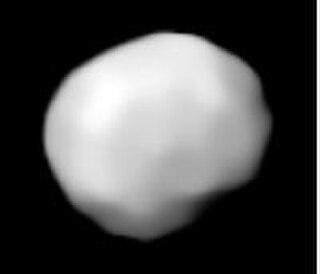
704 Interamnia is a large F-type asteroid. With a mean diameter of around 330 kilometres, it is the fifth-largest asteroid, after Ceres, Vesta, Pallas and Hygiea. Its mean distance from the Sun is 3.067 (AU). It was discovered on 2 October 1910 by Vincenzo Cerulli, and named after the Latin name for Teramo, Italy, where Cerulli worked. It is probably the fifth-to-tenth-most-massive asteroid, with a mass estimated to be 1.2% of the mass of the entire asteroid belt. Observations by the Very Large Telescope's SPHERE imager in 2017–2019, combined with occultation results, indicate that the shape of Interamnia may be consistent with hydrostatic equilibrium for a body of its density with a rotational period of 7.6 hours. This suggests that Interamnia may have formed as an equilibrium body, and that impacts changed its rotational period after it fully solidified.
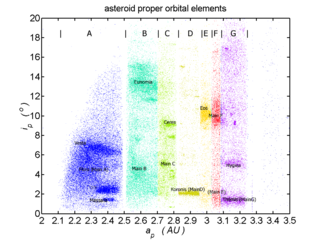
An asteroid family is a population of asteroids that share similar proper orbital elements, such as semimajor axis, eccentricity, and orbital inclination. The members of the families are thought to be fragments of past asteroid collisions. An asteroid family is a more specific term than asteroid group whose members, while sharing some broad orbital characteristics, may be otherwise unrelated to each other.

An achondrite is a stony meteorite that does not contain chondrules. It consists of material similar to terrestrial basalts or plutonic rocks and has been differentiated and reprocessed to a lesser or greater degree due to melting and recrystallization on or within meteorite parent bodies. As a result, achondrites have distinct textures and mineralogies indicative of igneous processes.

The Temple of Vesta, or the aedes, is an ancient edifice in Rome, Italy. The temple is located in the Roman Forum near the Regia and the House of the Vestal Virgins. The Temple of Vesta housed Vesta's holy fire, which was a symbol of Rome's safety and prosperity. The temple's most recognizable feature is its circular footprint. Since the worship of Vesta began in private homes, the architecture seems to pay homage to the architecture of early Roman homes. The temple used Greek architecture with Corinthian columns, marble, and had a central cella. The surviving structure indicates that there were twenty Corinthian columns built on a podium fifteen meters in diameter. The roof probably had a vent at the apex to allow smoke to release.

Vestas Wind Systems A/S is a Danish manufacturer, seller, installer, and servicer of wind turbines that was founded in 1945. The company operates manufacturing plants in Denmark, Germany, the Netherlands, Taiwan, India, Italy, Romania, the United Kingdom, Spain, Sweden, Norway, Australia, China, Brazil, Poland and the United States, and employs more than 25,000 people globally.

Mary Vesta Williams was an American singer-songwriter, who performed across genres such as pop, jazz, adult contemporary and R&B. Originally credited as Vesta Williams, she was simply known as Vesta beginning in the 1990s. She was known for her four–octave vocal range. She once sang "The Star-Spangled Banner" for the Los Angeles Lakers game opener using all four of those octaves. Although Williams never had any albums certified gold nor any Top 40 hits on the Billboard Hot 100, she scored six Top 10 hits on the United States Billboard R&B chart from the mid–1980s to the early–1990s that included "Once Bitten, Twice Shy" (1986), "Sweet Sweet Love" (1988), "Special" (1991), and her 1989 single and signature song, "Congratulations".
An asteroid spectral type is assigned to asteroids based on their emission spectrum, color, and sometimes albedo. These types are thought to correspond to an asteroid's surface composition. For small bodies that are not internally differentiated, the surface and internal compositions are presumably similar, while large bodies such as Ceres and Vesta are known to have internal structure. Over the years, there has been a number of surveys that resulted in a set of different taxonomic systems such as the Tholen, SMASS and Bus–DeMeo classifications.
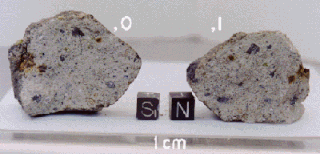
HED meteorites are a clan (subgroup) of achondrite meteorites. HED stands for "howardite–eucrite–diogenite". These achondrites came from a differentiated parent body and experienced extensive igneous processing not much different from the magmatic rocks found on Earth and for this reason they closely resemble terrestrial igneous rocks.

Ceres is a dwarf planet in the asteroid belt between the orbits of Mars and Jupiter. Ceres was the first asteroid discovered, on 1 January 1801 by Giuseppe Piazzi at Palermo Astronomical Observatory in Sicily. Originally considered a planet, it was reclassified as an asteroid in the 1850s after the discovery of dozens of other objects in similar orbits. In 2006, it was reclassified again as a dwarf planet – the only one always inside Neptune's orbit – because, at 940 km (580 mi) in diameter, it is the only asteroid large enough for its gravity to make it plastic and to maintain it as a spheroid.
Denbo is a populated place in the Centerville, Washington County, Pennsylvania, United States. It is a coal patch town, located near the former Vesta No. 6 Mine.

Parthian coinage was produced within the domains of the Parthian Empire. The coins struck by the Parthians were mainly made of silver, with the main currencies being the drachm and tetradrachm. The tetradrachm, which generally weighed around 16 g, was only minted in Seleucia, first conquered by the Parthians in 141 BC. Design-wise, Parthian coinage was based on Seleucid and Achaemenid satrapal coinage.















